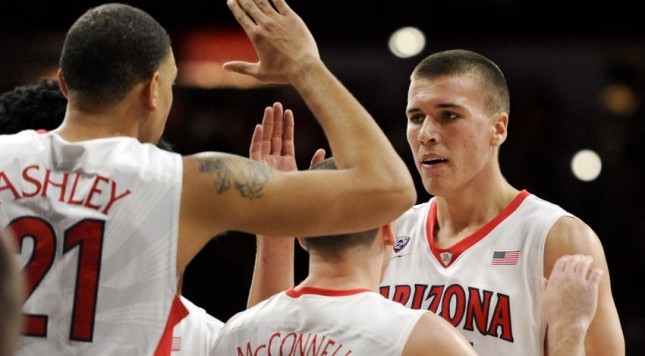The Arizona Wildcats lost at Oregon State last Sunday night. They played a very ordinary game against the going-nowhere Colorado Buffaloes on Thursday. It’s true that a lot of season remains — two whole months before the NCAA tournament starts — but if you thought Arizona was a Final Four contender, you wouldn’t have known it based on the past two weeks of Pac-12 competition. There are times during a season when a team with grand aspirations has to answer the call.
Arizona did exactly than on Saturday against its chief — and perhaps only — conference competitor in 2015, the Utah Utes.
*
Yes, Stanford is hanging around at 4-1 in the Pac, but there’s no question that Arizona and Utah have established themselves as the class of the league to this point. The Wildcats and Utes collected signature wins in non-conference play, demonstrating a resilience that’s a familiar sight in Tucson, but a foreign one in Salt Lake City… at least since the 2005 season under Ray Giacoletti.
As these teams faced each other on Saturday at the McKale Center near the Old Pueblo, Utah had earned the right to be seen on the same level as Arizona. Both teams stood in the top 10 of the national rankings. Both teams had staked a claim to ownership of the Pac-12. Utah was the in-form team, lending credence to the notion that it could go into Tucson and take control of the conference.
Though Arizona has achieved and proved more in college basketball — not just over the past few years, but over a much larger span of time — the Wildcats were the ones who had to win this game. Arizona had to hold serve at home, for one thing. Second, being a game behind Utah heading into the contest, the Wildcats had to keep pace with the Utes. Third, the loss at Oregon State raised fresh doubts about this team’s ability to compete at the highest level. A win over Utah wasn’t just important in the race for the Pac-12 title; it marked a moment in time when Arizona had to make a statement — not just to the nation, but to itself.
After 40 minutes of authoritative basketball, it’s safe to say the Wildcats offered a very loud and clear statement of how — and what — they are.
Tough. Not elegant or dazzlingly skilled, but tough.
Arizona, like other teams such as Louisville and Ohio State, struggles to hit the long ball. Utah didn’t go to a zone defense, however, and so the Wildcats — despite a slow start — were able to work their way back into the game in the first half because they knew that if they could power the ball to the basket, they wouldn’t have to hit jump shots.
The best player on the floor on Saturday was Arizona point guard T.J. McConnell. It was he who made sure the ball found his teammates’ paws on cuts or dives within three or four feet of the basket. McConnell hit several tough jumpers, finishing with 16 points, but his 6 assists and the overall ball movement he facilitated are what his coach and teammates will remember. McConnell, with his passing and floor leadership, showed what Arizona had to do in the face of its poor shooting and Utah’s swarming defense. In the second half, everyone on the U of A roster realized the importance of getting to the tin… and everybody succeeded in the attempt.
Not only did Arizona finish a lot of plays near the basket in this game — creating a 49-percent field goal rate for the Cats — but the U of A positioned itself to establish territorial dominance over the Utes. Arizona annihilated Utah on the glass, 40 rebounds to 19. The Wildcats owned a 17-4 advantage on the offensive glass, creating the many extra possessions which made the difference in this game. Arizona attempted 53 field goals compared to 41 for Utah. This advantage — and a subsequent differential of 10 more made field goals — offset the fact that the Utes drained nine threes to Arizona’s one.
The final margin (69-51) of 18 points seemed much more lopsided than the score indicated. Only Utah’s three-point shooting kept the final margin under 20.
It’s definitely true that Arizona still needs to find a more reliable jump shooter before the NCAA tournament. It’s probably true that Utah is going to be a tough out for Arizona when these teams reunite in Salt Lake City. Yet, for one day, the Wildcats didn’t have to hear about how shaky their house is. Arizona stands on solid rock, not quicksand, after punching Utah in the mouth and reminding the Utes that in order to ascend to the mountaintop in basketball, you normally have to lose a little before you can win at a high level.
Arizona didn’t make the Final Four last season — the Wildcats had to endure the pain of a near miss. Yet, that pain seemed to help Sean Miller’s team this past Saturday. The kind of urgency Arizona summoned on court was exactly what you’d expect of a team driven by a haunting memory.
Conversely, Utah hadn’t been haunted yet this season. The Utes have finally received that kind of baptism now.
This wasn’t an end in the 2015 Pac-12 race. Arizona’s win — and Utah’s encounter with frailty — suggest that this two-team race is only beginning to take on added tones and textures.

